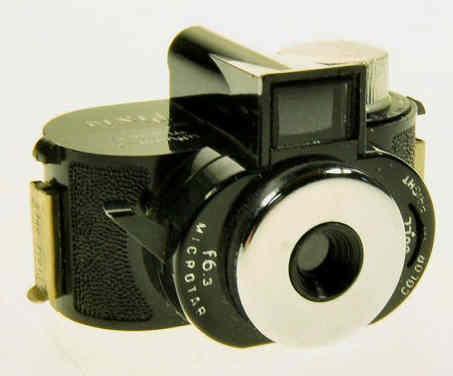
WHITTAKER SUBMINIATURES

The Whittaker Company started out making parts for airplaines and somehow after the War, in the late 1940's, they decided to get into the subminiature camera business. But stranger things have happened in the photographic world, for sure. Anyway, their (ad)venture didn't last very long, and they only made two, or three, or four submini cameras over time. They were actually just variants of the same camera so it best to say that their camera(s) just evloved over time..
(1950) Even though it was smaller than a pack of cigarettes -- and perhaps designed to fit in one -- this all metal submini is pretty heavy. If you plan on putting it in a cigarette package, make it a hard-pack. The Micro 16 has a single speed shutter (1/50) combinded with a mediocre, two-element, fixed-focus, f6.3 lens. The f-stop is adjustable, however, with three settings, -- "BRIGHT", "DULL", and "COLOR" -- which were changed with a finger-nail tab on the front of the camera. These are probably f6.3, 11, and 16. A protruding tab on one end of the camera is pushed in to advance the film and cock the shutter. The camera "evolved" slightly over time. The camera has a built-in waist-level viewfinder, but later, a slip-on, slide-out viewfinder -- like on the later Mamiya 16 -- was available. And the later models have some red paint added to the front settings -- big deal. The camera was available in chrome (most common), as well as black, blue, and green. A film advance "tooth" pushes the film from one cassette to another, similar to the Steky and later Rollei 16mm cameras. The Micro 16 was designed for perforated film -- but single or double perf will work fine. Tripod socket and exposure counter (to 24) on the bottom.
(1950) It's the same lens (f6.3) and shutter (single speed) as the Micro 16, but in a completely redesigned body -- much smaller -- in a lighter, plastic/bakelite package. It has the same single shutter speed (1/50) and the same three aperture settings -- "BRIGHT", "DULL", and "COLOR", but the reflex and slide-out viewfinders are gone. Instead a simple viewfinder was added to the top. The other big difference was the film cassette. Instead of two separate cassettes, it used a single, small, double-lobed cassette. In addition, the film counter is now on the top of the camera -- on the exterior!
You can call it the same camera as the original Pixie, but this model/version allowed for a separate, impressive, HUGE flash unit -- and it cost twice as much as a result.

To return to the main index for the Sub Club click here.
COPYRIGHT @ 1995-2018 by Joe McGloin. All Rights Reserved.